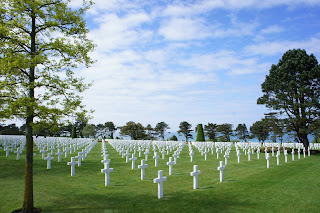World War I memorial marker on a country road, Normandy, France
The year I turned two years old, musician and composer Benjamin Britten debuted his monumental piece “War Requiem,” which was recently reviewed in the Wall Street Journal in an article titled “The Sounds of Sacrifice.”
For the text, Britten selected nine poems by Lt. Wilfred
Edward Salter Owen, who died on the battlefield in 1918—interweaving the lyrics
into the traditional Mass for the Dead. The musical pieces (which you can check
out on YouTube) will shake you to the core with their intensity. At the same time, however, I find the
words, the poems, disarming and moving in their honest simplicity.
War Requiem: "Agnus Dei" by Benjamin Britten
On our recent French pilgrimage, I was struck by how recent
and relevant the two World Wars are in that part of the world. We visited
churches and cathedrals destroyed by bombings; towns that had been occupied by
the enemy then liberated; and of course, cemeteries that spoke their own
unique, silent story.
I suppose it makes sense that in a landscape where history can be seen and touched that
dates back 1,000 years, the 1940s are deemed very recent to the collective
memory of that region.
Above is the Chapelle Notre Dame de la Paix, Our Lady of Peace, in the village of Saint-Mère Eglise, where American paratroopers converged in the early morning hours of June 6, D-Day. This set the events of that historic day in motion, beginning with the taking of Utah Beach.
Utah beach
 |
| “The allied forces landing on this shore which they call Omaha Beach liberate Europe –June 6th 1944” |
Monument "Les Braves" at Omaha Beach
local roads are named after the soldiers killed on D-Day
 |
| Infamous Point du Hoc, 4 miles west of Omaha Beach, where the cliffs proved deadly for American troops trying to reach the German bunkers |
American cemetery at Normandy
Stained glass featuring the paratroopers at the Saint-Mère Eglise chapel
Our Lady of Peace, pray for us














No comments:
Post a Comment